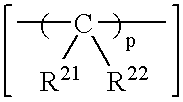Proplyene polymer composition, molded object, and polyolefin copolymer
a polymer composition and polyolefin technology, applied in the field of polyolefin copolymer, can solve the problems of polypropylene embrittlement upon deformation, disadvantageous increase in cost, unsatisfactory physical properties, etc., and achieve excellent impact strength and tensile strength, high rigidity
- Summary
- Abstract
- Description
- Claims
- Application Information
AI Technical Summary
Benefits of technology
Problems solved by technology
Method used
Image
Examples
referential example
[0159] A linear high-density polyethylene (U.S. Department of Commerce National Institute of Standards and Technology, SRM 1475) was subjected to the aforementioned temperature rising elution fractionation chromatography. Through the analysis, the highest elution temperature was found to be 100.6° C.
example 1
[0160] A pressure-resistant autoclave made of stainless steel having a volume of 2 liter and equipped with an agitator was heated to 80° C., and the inside of the autoclave was sufficiently dried under reduced pressure. The internal pressure of the autoclave was increased to atmospheric pressure by the use of dry nitrogen, and the internal temperature was reduced to room temperature. Under dry nitrogen flow, 1.0 liter of dried heptane, 5×10−3 mol as reduced to Aluminum atom of MAO (methylaluminoxane), and 10.0×10−6 mol of heptane slurry made from bis(pentamethylcyclopentadienyl) hafnium dichloride (CP*2HfCl2) were fed to the autoclave, and a mixed gas of ethylene (1.2 NL / min) and propylene (10.0 NL / min) was passed through the autoclave at 25° C. such that the total pressure was controlled to 0.6 MPa G, to thereby perform polymerization for 60 minutes.
[0161] After completion of reaction, unreacted monomers were removed by releasing pressurization, and thoroughly removed through purg...
example 2
[0171] The procedure of Example 1 was repeated, except that the amount of macro monomer solution fed during the copolymerization of propylene and an ethylene-co-propylene macro monomer was changed from 600 ml to 200 ml (80 g as macro monomer), to thereby yield 368 g of polyolefin copolymer (graft copolymer).
[0172] The produced polyolefin copolymer was subjected to temperature rising elution fractionation chromatography, and a fraction eluted at 101° C. or higher was analyzed through 13C-NMR. In the 13C-NMR spectrum, peaks attributed to ethylene chains were observed. The triple chain peaks satisfied the following equation: EP*E×PE*E / (PP*E×PE*P)=2.45.
[0173] In a manner similar to that of Example 1, the produced polyolefin copolymer was pelletized, and the pellets were injection-molded by means of an injection molding machine, to thereby prepare test pieces which were evaluated in terms of physical properties.
[0174] Physical properties of the polyolefin copolymers and evaluation of ...
PUM
| Property | Measurement | Unit |
|---|---|---|
| Temperature | aaaaa | aaaaa |
| Temperature | aaaaa | aaaaa |
| Fraction | aaaaa | aaaaa |
Abstract
Description
Claims
Application Information
 Login to View More
Login to View More - R&D
- Intellectual Property
- Life Sciences
- Materials
- Tech Scout
- Unparalleled Data Quality
- Higher Quality Content
- 60% Fewer Hallucinations
Browse by: Latest US Patents, China's latest patents, Technical Efficacy Thesaurus, Application Domain, Technology Topic, Popular Technical Reports.
© 2025 PatSnap. All rights reserved.Legal|Privacy policy|Modern Slavery Act Transparency Statement|Sitemap|About US| Contact US: help@patsnap.com



